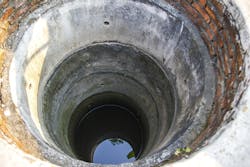New online tool estimates local arsenic and fluoride contamination
SWITZERLAND — April 28, 2016 — A new online platform for estimating arsenic and fluoride contamination in a given area was developed by the Swiss Federal Institute of Aquatic Science and Technology (Eawag).
The free, interactive Groundwater Assessment Platform (GAP) enables authorities, NGOs and other professionals to upload their own data and generate hazard maps for their areas of interest.
Announcing the new tool, Eawag said that in developing countries a lack of technical and financial resources can make it almost impossible for authorities to perform the complex task of producing arsenic or fluoride hazard maps without assistance. The online solution is based on a statistical model that uses data on geology, topography and soil properties.
Arsenic in drinking water from private wells may increase bladder cancer risk in New England
BETHESDA, Md. — May 2, 2016 — Drinking water from private wells may have contributed to the elevated risk of bladder cancer that has been observed in northern New England for more than 50 years, the National Institutes of Health (NIH) said. The incidence of bladder cancer in Maine, New Hampshire and Vermont is about 20 percent higher than in the U.S. overall.
The study involved researchers at the National Cancer Institute (NCI), part of the NIH, and colleagues at the Geisel School of Medicine at Dartmouth, Hanover, N.H.; the departments of health for Maine, New Hampshire and Vermont; and the U.S. Geological Survey.
The researchers noted that a unique feature of this region is the high proportion of the population using private wells for their drinking water. These are not maintained by municipalities and are not subject to federal regulations. Such wells may contain arsenic, generally at low to moderate levels, the NIH said.
Focusing on participants who had used private wells, they found that people who drank the most water had almost twice the risk of those who drank the least. This association was stronger if dug wells had been used, particularly those established during the first half of the 20th century. Dug wells are shallow, less than 50 feet deep, and potentially susceptible to contamination from manmade sources.
Fireworks blamed for perchlorate contamination at Mount Rushmore
RESTON, Va. — May 2, 2016 — Independence Day fireworks displays that took place around 1998 to 2009 at the Mount Rushmore National Memorial contaminated the groundwater and surface water with a compound called perchlorate, new research suggests.
Perchlorate is used as an oxidizing agent in fireworks. At high levels in drinking water, perchlorate can interfere with the function of the human thyroid gland. However, the drinking water at Mount Rushmore meets current regulations and is safe for public consumption, the U.S. Geological Survey (USGS) said.
A maximum perchlorate concentration of 54 micrograms per liter (µg/L) was measured in a stream sample, and 38 µg/L in a groundwater well. In contrast, all groundwater and stream samples collected from sites outside the memorial boundary had perchlorate concentrations less than 0.2 µg/L.
Perchlorate levels in drinking water are not currently regulated by the U.S. Environmental Protection Agency, but the park plans to carry out additional voluntary monitoring and treatment.
Chemical spill at Pennsylvania water treatment plant is contained
TULLYTOWN, Pa. — May 5, 2016 — Hazardous materials specialists responded to a chemical spill at a water treatment plant in Bucks County, Pennsylvania, early Thursday.
According to local newspaper the Bucks County Courier Times, the leak at the Tullytown plant involved a malfunctioning valve at the bottom of a 12,000-gallon tank which contained 9,000 gallons of ferric chloride, a highly corrosive chemical solution that is used in sewage treatment and water purification.
A county hazardous materials team contained and slowed the leak and the site was fully operational again by early Thursday afternoon.
The Pennsylvania Department of Environmental Protection (DEP) confirmed that local drinking water supply was not affected. DEP spokeswoman Virginia Cain also said that the chemical did not enter any waterways and air monitoring had not detected any contamination as of early Thursday afternoon.


